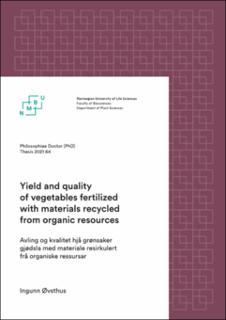| dc.description.abstract | Agriculture, aquaculture, fishery and households generate large amounts of organic wastes with high contents of nitrogen (N) and other nutrients. Concurrently, supply of off-farm N resources into horticultural production systems is essential to gain desirable yields, quality and economic outcome. Turning organic wastes into fertilizer resources can contribute to meeting the requirement of nutrients without consuming non-renewable resources will contribute to “closing the loop” and thus a more circular economy recycling nutrients from such locally available organic resources.
However, recycling nutrients from organic materials is a complex task, and knowledge about nutrient dynamics is important for optimizing fertilizer effect without causing detrimental impacts on the environment. In particular, the N dynamics of organic materials requires substantial attention, due to the complexity of pathways in the N cycle and their potentially negative impacts on the environment. These processes depend upon the biochemical quality of the organic fertilizer materials and external factors such as temperature and moisture and soil texture and structure. There is a risk of loss of N through nitrate leaching, ammonia volatilization or fixation, and denitrification.
Horticultural products are an important nutritional source for humans. Vegetables, fruit and berries are associated with a healthy diet. Fertilization strategy influences both internal and external product quality, and especially N fertilization is linked to yield and, hence, economic profit, as well as contents of nutritional value and taste. Knowledge about the N mineralization and immobilization from organic fertilizer resources is required to ensure a high degree of resource utilization and optimal quality of the horticultural produce. N models have been widely used to increase our understanding of how N dynamics influences the yield and environmental impact in both conventional and organic production systems.
The overall aim of this thesis was to investigate the effect of fertilization with materials recycled from organic resources on yield and quality of selected vegetables. An incubation experiment with nine organic materials of different origin (anaerobically digested food wastes (AD), shrimp shell pellets (SSP), shrimp shell powder (SSM), meat bone meal (MBM), dried fish waste sludge (FW), sheep manure (SM), algal meal (AM) and meals of Laminaria digitata (LD) and Saccharina latissimi (SL)) was set up to determine the carbon (C) and N mineralization patterns. Broccoli, potato and lettuce were grown at two locations, Grimstad (58°N and 8°E) and Bodø (67°N and 14°E), with anaerobically digested food wastes, shrimp shell pellets, sheep manure and algal meal as fertilizers to investigate effects on yield, N use efficiency and selected quality parameters. The C and N mineralization data obtained during incubation and results from the field experiment in Bodø were used to calibrate and evaluate the EU-Rotate_N model. Based on net N mineralization, the organic materials were divided into three groups: N-rich industrial wastes which had a high initial N mineralization rate followed by a low rate (SSP, SSM, FW, MBM), materials with high initial mineral N content and further low rate of N mineralization (AD and SM), and seaweeds, which caused initial N immobilization followed by slow (SL and LD) or no (AM) N mineralization. Crop yield, N recovery efficiency and crop quality parameters could to a large extent be explained by the plant-available N from the different fertilizer materials as estimated from the mineralization data. However, sensory attributes of broccoli were affected by years. EU-Rotate_N was successfully calibrated for N-rich materials
of industrial origin, whereas seaweeds, AD and SM proved to be difficult. The model’s ability to predict was evaluated with soil and crop data of broccoli and potato fertilized with AD, SSP, SM, AM, and mineral fertilizer (MF). The model satisfactorily predicted dry matter and N contents of the above-ground part of broccoli fertilized with AD, SSP and MF, but not AM, and of potato after adjusting critical %N for optimum growth. Prediction of soil inorganic N after harvest was poorer.
In conclusion, the N-rich organic materials of industrial origin (SSP, SSM, MBM and FW) and AD have the potential to replace N from mineral fertilizer in conventional vegetable production systems or as complementary fertilizers in organic production systems. The decomposition of and N availability from seaweed species were not fully understood. The EU-Rotate_N model can be used as a learning tool for understanding the decomposition and N mineralization dynamics of organic materials and, thus, serve as a decision support tool for their use as fertilizers. | en_US |
| dc.description.sponsorship | This PhD Thesis was a part of the project Pre- and postharvest quality optimisation of organic vegetables that can stimulate an increased consumption (NFR 176767), which was led by researcher Dr. Randi Seljåsen, Norwegian Institute of Bioeconomy Research (NIBIO) and funded by the Research Council of Norway, The Council of Nordland and Troms, and NIBIO. | en_US |

